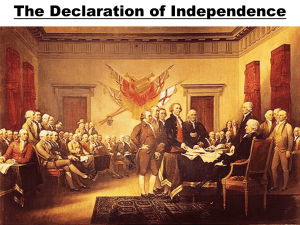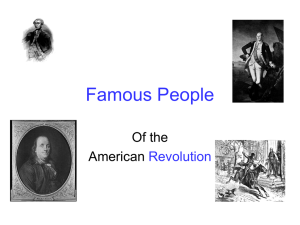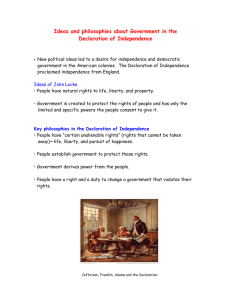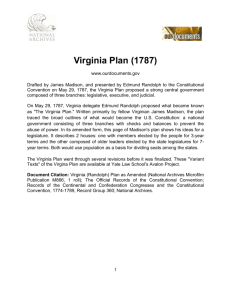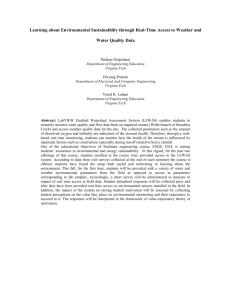Extension Activities
advertisement
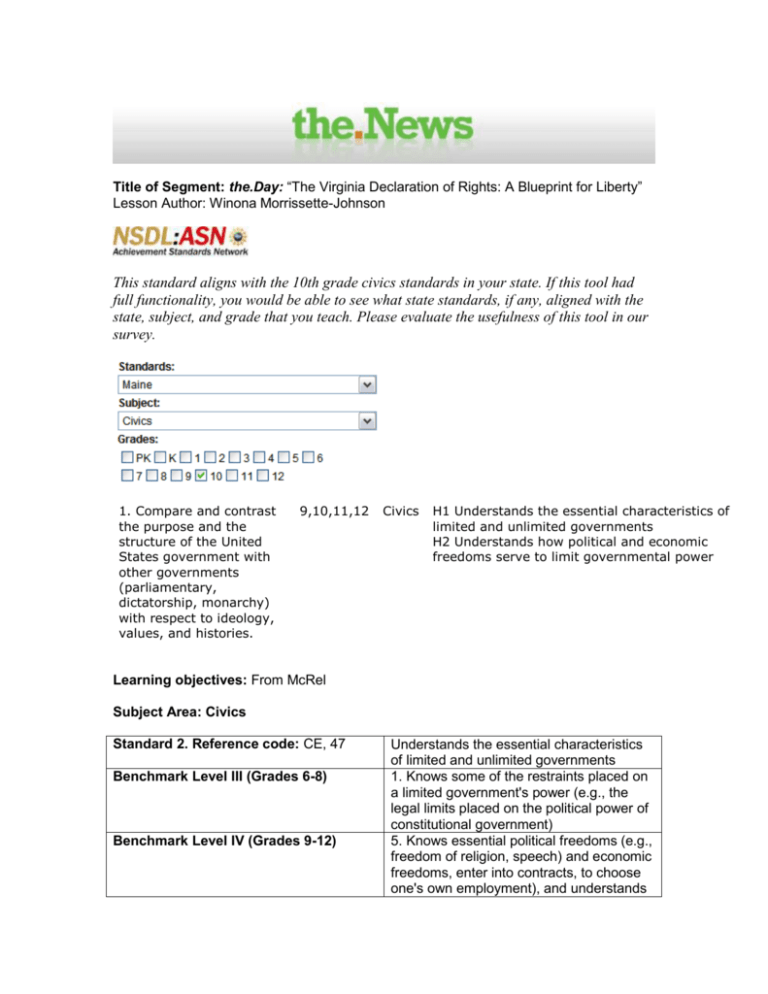
Title of Segment: the.Day: “The Virginia Declaration of Rights: A Blueprint for Liberty” Lesson Author: Winona Morrissette-Johnson This standard aligns with the 10th grade civics standards in your state. If this tool had full functionality, you would be able to see what state standards, if any, aligned with the state, subject, and grade that you teach. Please evaluate the usefulness of this tool in our survey. 1. Compare and contrast the purpose and the structure of the United States government with other governments (parliamentary, dictatorship, monarchy) with respect to ideology, values, and histories. 9,10,11,12 Civics H1 Understands the essential characteristics of limited and unlimited governments H2 Understands how political and economic freedoms serve to limit governmental power Learning objectives: From McRel Subject Area: Civics Standard 2. Reference code: CE, 47 Benchmark Level III (Grades 6-8) Benchmark Level IV (Grades 9-12) Understands the essential characteristics of limited and unlimited governments 1. Knows some of the restraints placed on a limited government's power (e.g., the legal limits placed on the political power of constitutional government) 5. Knows essential political freedoms (e.g., freedom of religion, speech) and economic freedoms, enter into contracts, to choose one's own employment), and understands Standard 8. Reference code: CE, 53, 100 competing ideas about the relationships between the two (e.g., that political freedom is more important than economic freedom, that political and economic freedom are inseparable) 6. Understands how political and economic freedoms serve to limit governmental power Understands the central ideas of American constitutional government and how this form of government has shaped the character of American society (Additional: Benchmark Level III (Grades 6-8): 4,5; Benchmark Level IV (Grades 9-12: 1,2 6,8,9) Standard 25. Reference Code CE, 128-129 Benchmark Level III (Grades 6-8) 1, Benchmark Level IV Grades 9-12) 1,5 Subject Area: Historical Understanding Standard 2. Reference code: BI, 60-61; AI,18-19; GE.25; WI.18-19 Benchmark Level III (Grades 7-8) 1,2 Benchmark Level IV (Grades 9-12) 1,2,10 Background: The Virginia Declaration of Rights was originally drafted by George Mason in May of 1776 and, after some revision, unanimously adopted by the Virginia Convention of Delegates on June 12 of that same year. The guarantees of liberty Mason included in the Virginia Declaration of Rights were not new ideas. They originated from the writings of natural rights philosopher, John Locke, from the rights of Englishmen outlined in the Magna Carta (1215) and the English Bill of Rights (1689). The importance of the Virginia Declaration of Rights is that it was the first constitutional protection of individual rights and it served as a blueprint for later founding documents. Thomas Jefferson quotes it in the opening paragraphs of the Declaration of Independence (1776). James Madison was influenced by it when he drafted the United States Bill of Rights (1787). Many colonial governments also used it as the basis for their bill of rights and even the Marquis de Lafayette drew from it when composing the French Revolution’s Declaration of the Rights of Man and Citizen (1789). . Key Concept: constitutional or limited government Key Vocabulary: 1. Right: a power or privilege that a person has by law, nature or tradition. 2. Unalienable Rights: the fundamental rights of the people that may not be taken away. 3. Natural Rights: the rights all human beings have had since the time before government existed (the state of nature) 4. Political Rights: all of the rights of citizenship guaranteed by the law and granted by government. 5. U.S. Bill of Rights: refers to the first 10 amendments to the U.S. constitution, which sets forth individual liberties while placing certain limits on government. 6. Social Contract theory: the philosopher John Locke and others believed that people agreed to give up some of the rights they possessed in “the state of nature” to receive the security and protections of government. 7. Constitution: a set of rules and laws that sets forth the way a government is organized 8. Constitutional Government (a.k.a. limited government): the powers of the government officials are restrained by a set of laws and customs called a constitution. Government cannot infringe on the rights of the people or abuse its powers. LESSON PLAN: “The Virginia Declaration of Rights: An important step toward the protection of individual rights” Subjects: U.S. History, U.S. Government, Civics, Grade Levels: Middle School (6-8) High School (9-12) Time: One 90-minute class period or two 50-minute periods Lesson Objectives: At the conclusion of this lesson students will be able to: 1. Define what rights are; 2. Contrast political rights with natural rights; 3. Explain how John Locke’s philosophies and the Founders’ British roots influenced their ideas about rights; 4. Identify specific examples these ideas expressed in the Virginia Declaration of Rights and other founding documents; 5. Define constitutional government; 6. Explain how a constitutional government functions and identify the specific methods used to control and limit governmental power; 7. List specific examples of constitutional government included in the Virginia Declaration of Rights; 8. Demonstrate knowledge of how America’s constitutional government and Bill of Rights functions to protect the rights of its citizens and to limit the powers of government; Materials Needed the.News segment titled “The Virginia Declaration of Rights: A Blueprint for Liberty” A copy of the Virginia Declaration of Rights A biography on John Locke Access to the Internet Procedures for Teachers 1. After viewing the.News segment, 2. Begin the lesson with a Warm up Activity: Ask students to answer the following questions: a. What are rights? b. Where do rights come from? c. Why do you think it is important to protect rights? d. Can you think of one way your rights are protected in the United States? Allow 2-3 minutes of discussion for each question 3. As an introduction to the concept of rights place the following definitions on the board: Right: a power or privilege that a person has by law, nature or tradition. Natural Rights: the rights that all human beings have had since the time before government existed (the state of nature). Political Rights: all of the rights of citizenship guaranteed by law and granted by government. Accompanying Notes: Teachers should explain to students that the way a society views and defines rights will have a major impact on how its government functions. Natural Rights are not granted by government, but by a higher power. This means that the government may not always protect all natural rights. On the other hand, Political Rights are created by a government, and protected by law. Unfortunately, the rights a government grants, it can also take away. The Virginia Declaration Rights was an important milestone in the development of colonial government because the law was protecting the political and natural rights of citizens. 4. Next check for student understanding (formative assessment): Direct students to the National Archives website: http://www.archives.gov/national-archivesexperience/charters/virginia_declaration_of_rights.html Students will identify a political right and a natural right protected in the Virginia Declaration of Rights. Students must defend their choices by referring to the definitions. Provide time for students to share and discuss their answers. Teachers should listen for understanding of the terms and provide additional instruction if necessary. 5. Distribute a brief biography on John Locke and his philosophies and provide ample time for students to read it. http://www.history.com/encyclopedia.do?articleId=214980 6. Next, teachers should explain that John Locke’s writings were a major influence on the development of government in colonial America. The Founders believed that protecting natural rights was an important function of government. 7. Have students form a think pair, and then ask them to write a brief summary of Locke’s philosophy based on their reading. 8. Check for student understanding (formative assessment) by allowing several pairs of students to read their summaries to the class. Accompanying Notes: At the conclusion of this activity emphasize to your students that Locke established the basis for constitutional government in his Two Treatises of Government (1690) www.constitution.org/jl/2ndtreat.htm In it he expresses the view that the primary purpose of government is the protection of natural rights and in order to achieve its purpose government’s power should be limited and controlled by the people. It is also important that teachers emphasize that the rights expressed in the Declaration of Rights were rights the Virginia colonist believed they were entitled to as Englishmen. They used the following British documents to develop their rights in America: the Magna Carta (1215), http://www.archives.gov/exhibits/featured_documents/magna_carta/, The Petition of Rights (1628) www.constitution.org/eng/petright.htm and the English Bill of Rights (1689) www.constitution.org/eng/eng_bor.htm 9. Direct students back to the National Archives website: http://www.archives.gov/national-archivesexperience/charters/virginia_declaration_of_rights.html Each student will identify and make a list of the specific quotes from the Virginia Declaration of Rights that they feel places a limit on the powers of government. Review the students’ lists with them by placing a master list of all responses on the board. Have students copy this list into their notes. 10. Check for student understanding (Cumulative Assessment): Have students answer the following questions as a closing activity (if time permits) or as homework. a. Contrast a natural right with a political right. b. Cite one example of a political right expressed in the Virginia Declaration of Rights. c. Why did the authors of the Virginia Declaration decide to include natural rights in the document? Was this unusual? d. Explain how the citizens of Virginia were able to ensure that their government would not exceed the powers granted to it in their state constitution. e. Contrast a constitutional government with a government that has a constitution. Extension Activities 1. Critical Thinking Exercise A “Analyzing the Declaration of Independence” Introduction p. IX; We the People Level III Student Textbook, published by the Center for Civic Education (1995) 2. Critical Thinking Exercise C “Examining Your Knowledge of the Bill of Rights” Introduction p. X; We the People Level III Student Textbook, published by the Center for Civic Education (1995) 3. Students will create a cartoon that illustrates the concept of limited government. Additional Resource: http://www.doyouhavetheright.org A website created by the Bill Of Rights Institute exclusively for students. ------------------------------------------------------------------------------------Language Arts/Media Literacy Lesson Author: Julie Weiss, Ph.D Goals 1. To understand the difference in reporting about the past and covering current events 2. To investigate ways to cover historical events Learning Objectives (McRel Standards) Language Arts Standard 9 Level III: 1, 2, 3, 5, 7, 8 Level IV: 1, 2, 3, 6, 8 Language Arts Standard 10 Level III: 1, 5, 6, 7 Level IV: 8, 10, 12 Key Concepts The challenge to journalists who cover historical events is to make their stories relevant to a 21st century audience. Words and visuals selected by the journalists are the tools by which they can make these stories interesting. Background The purpose of the.Day is to describe an historical event. Many of the production elements in the story about The Virginia Bill of Rights came from the Williams Educational Foundation. Their collection of footage about this period in history as well as access to primary sources contributes to the authenticity of this content. This lesson allows students to take on the role of the journalist and to make choices about how to report on an historical event. Key Vocabulary commonwealth subjects (of the King of England) cornerstone inherent blueprint FOR STUDENTS: I. The Words You Choose In civics and history classes you learn about the founding documents. Because they were written a long time ago, those documents use archaic language that can make the ideas in the documents seem old-fashioned too. But they’re not! How can reporters show that these very important past documents are worthwhile today? That’s what you’re going to do in this lesson. Here is a list of phrases from “The Virginia Bill of Rights: milestone in colonial American history cornerstone of American freedom subjects of the King of England inherent…or basic…rights unreasonable searches by government officials free exercise of religion a new relationship between citizens and government Print out a copy of the script for this segment at the.News web site. Find these phrases and highlight them. Working with a partner, rewrite each of the phrases in language that is more consistent with today’s usage. For example, instead of “inherent or basic rights,” you might say “rights that can’t be taken away.” Download the script into a word processing document. Change it, replacing the phrases above with the words and phrases you and your partner have created. Read your revised scripts to the class. Does the different word choice affect your comprehension? Your interest in the story? II. The Images You Use Just as word choice can attract audience members, so can the choice of visual images. Look at the part of the Virginia Bill of Rights report that lists the five rights that were part of the Declaration of Rights. What visual images could you use to show each of the rights, rather than listing them in words? Come up with modern-day visual images, (such as someone going into a voting booth or a lawyer speaking to a jury). List the images, or, if you have the technology, create them so that they could be inserted into the story to accompany the voice over that lists the rights. Wrap-Up Discussion Compare the the.Day report on the Virginia Bill of Rights with your changed version of that report. Are there benefits to sticking to the language in the original document? Are there benefits to changing the language and incorporating modern-day images? Writing Take a position for or against one of the “rights” listed in this story. Then, write a persuasive essay in which you support your argument. Be sure you clearly state your point of view. Offer supporting evidence and arguments from the Virginia Bill of Rights at http://www.nhinet.org/ces/docts/va-76htm Write a press release about the announcement of the Virginia Bill of Rights to the citizens of Virginia in 1776.
